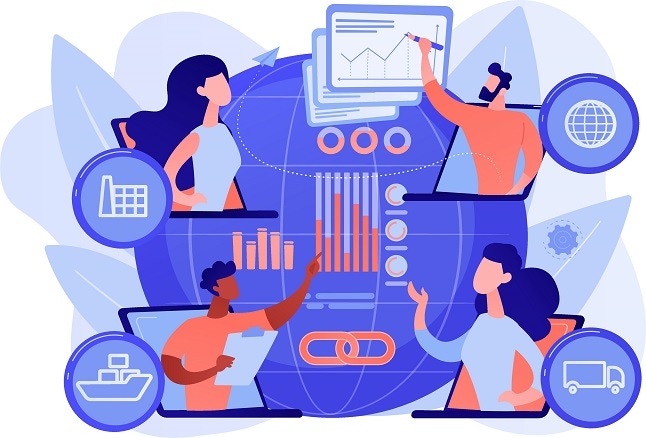Company leaders must enhance the resilience of supply chains to prepare their organizations for further market disturbances. Here are four things they need to do.

Supply chain managers and chief product officers were slowly preparing to improve and digitize supply chains. But when the pandemic hit -- most were ill-prepared.
Only the most resilient and agile companies managed to survive those difficult times. But as harsh as this sounds -- this unprecedented turn of events can now be seen as a stimulant to faster adoption of new supply chain management strategies.
Most of them include the digitization of the supply chain to gain real-time inventory visibility and start making informed decisions based on real data.
The pandemic caused fuel shortages, soaring inflation, scarcity of raw materials, and the rising cost of containers and shipping. Disruptive armed conflict like the Russia-Ukraine war is again testing the resilience of supply chains.
These crises show company leaders that risk planning is not an option. They must be prepared for what is next to come. To be able to do that, companies need to improve the visibility of supply chains where they are most vulnerable and start working on their resilience.
Here are four ways that company leaders and supply chain officers can and must prepare their organizations for further market disturbances.
1. Warehouse automation
The warehouse is where the fulfillment meets the road. It is here that bottlenecks can form and foment customer discontent. Organizations are increasingly tapping into automation technology to reduce human intervention in everyday warehousing services and processes. Automation is thus taking over everything from inventory management to product flow.
The benefits cascade into the rest of the supply chain and fulfillment process including reducing driver wait time, minimizing errors, and enhancing the tracking of goods as they move from one point to another.
Supply chain managers can even triangulate package locations and monitor movement between distribution centers to fulfillment centers to the end customer. If otherwise left to manual intervention, these processes would consume sizable amounts of manpower, time, and money which would only serve to drag down business efficiency.
2. Data quality over data quantity
The scale of data generated by systems used along the entire supply chain is enormous. And the volume will only continue to grow. Such an avalanche of data can be overwhelming and often does not offer increasing value commensurate with its increasing size. Managers want better data on shipment and goods as opposed to just ever-increasing acres of information.
Organizations are leaning toward the extraction of actionable information that can be transferred to and facilitate collaboration with business partners and other players in the supply chain. These could be shippers, transport providers as well as third-party logistics companies -- all of which would facilitate more informed decision-making.
Examples? Think about product utilization data. Or how much time the cargo has spent in a stationary position. Or whether a truck door has been opened. Or the road-readiness of the truck. Or how long perishable goods have been inside a truck. This information could be gathered from edge computing devices, telematics solutions, flight/ocean data, and other sources that relay more contextual insights.
3. Nearshoring
One thing the COVID-19 pandemic laid bare was just how dependent businesses were on manufacturers and suppliers thousands of miles away. As factories in China saw weeks and months of closures or reduced production, businesses struggled to meet or manage customer demand.
In the aftermath, more supply chain managers are embracing nearshoring by working with manufacturers, suppliers, and warehouses closer to their customers. They are also adopting regionalization as a means of moving distribution and fulfillment centers closer to their clients.
For nearshoring and regionalization to work effectively, it should be supported by real-time business data that can pick up supplier overdependence, the geographical distribution of product demand, and looming threats to future production. Such real-time data could be drawn from sources such as sensors, connected devices, and other visibility-enhancing systems.
4. Sustainability
Circular economy, climate change, social impact, and governance initiatives are driving the conversation around more sustainable business. Supply chains are at the heart of driving sustainability. However, while many businesses have shown intent to shift toward sustainable practices, there is still a sizable gap between intention and implementation.
An Oxford Economics survey found that nine in 10 supply chain executives were developing or had developed a mission statement on sustainability. Yet just one in two had tried to reduce shipping miles and only one in five had full visibility into product sourcing.
Businesses are increasingly adopting visibility-enhancing technologies and working with suppliers that provide real-time insights on processes that precede the delivery of goods to their warehouses. We are talking about, for instance, smart factories that leverage artificial intelligence and machine learning to extract and share information on happenings on the factory floor.
Wrapping Up
There is no predicting with certainty what supply chain trends will look like years, months, or even weeks from now. As COVID-19 showed, stable seamless supply chains can be quickly upended by a pandemic, conflict, and other large-scale disaster events.
What is certain though is that technological innovation and adoption is a central pillar in navigating supply chain trends and circumventing any new challenges they introduce. The end goal is to enhance supply chain resilience, agility, and overall business efficiency.
Read more about:
Supply ChainAbout the Author(s)
You May Also Like







